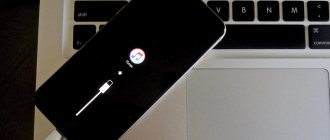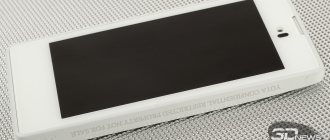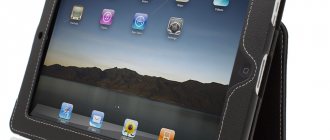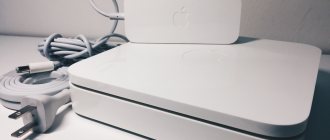On September 14, 2022, the presentation of the new generation iPhone took place, which includes four versions of smartphones: basic, Mini, Pro and Pro Max. No one expected revolutionary solutions from Apple, but the release of the miniature iPhone 13 Mini came as a surprise given the low popularity of the mini version of its predecessor.
Source: ixbt.com
The new products differ among themselves in display sizes, camera configurations and characteristics. At the same time, there is a lot in common between the iPhone 13 and iPhone 13 Mini, as well as between the iPhone 13 Pro and iPhone 13 Pro Max.
Let's look at everything in more detail and find out how much the new generation smartphones have surpassed the previous series, and whether iPhone 12 owners should upgrade or the overpayment is not justified.
Characteristics of all versions of iPhone 13
Let's start by comparing the technical parameters and sizes of the new products. The iPhone 13 Mini differs from the regular iPhone 13 only in size. The release of the mini version is due to the fact that there are few powerful smartphones of a similar form factor on the market.
| iPhone 13 Mini | iPhone 13 | iPhone 13 Pro | iPhone 13 Pro Max | |
| Display size | 5,4” | 6,1” | 6,1” | 6,7” |
| Screen resolution | 2340×1080 | 2532×1170 | 2532×1170 | 2778×1284 |
| Update rate, Hz | 60 | 60 | 120 | 120 |
| Camera, MP | 12 + 12 | 12 + 12 | 12 + 12 + 12 | 12 + 12 + 12 |
| CPU | Apple A15 Bionic | Apple A15 Bionic | Apple A15 Bionic | Apple A15 Bionic |
| Memory, GB | 128 / 256 / 512 | 128 / 256 / 512 | 128 / 256 / 512 / 1024 | 128 / 256 / 512 / 1024 |
| Dimensions, mm | 131.5x64.2x7.65 | 146.7x71.5x7.65 | 146.7x71.5x7.65 | 160.8x78.1x7.65 |
| Weight, g | 140 | 173 | 203 | 238 |
iPhone 13 design - what has changed
Externally, the 13th generation smartphones are very similar to the previous model range, but new color options have been added. Instead of green and purple, the iPhone 13 line included blue and pink, and in the Pro line, blue gave way to sky blue.
The following options are available:
- for iPhone 13 and 13 Mini – black (dark night), blue, white (shining star), red, pink;
- for Pro and Pro Max – black (graphite), gold, silver, sky blue.
The connecting frame has strict edges protruding at right angles, which will remind many of the laconic iPhone 4 and, of course, the previous 12th generation. The latest Apple tablets, the iPad Pro, also received similar edges.
The body of the new iPhone 13 is made of aluminum, so the smartphones are durable and lightweight. The screen was protected with durable Ceramic Shield glass, which was used in the previous model.
Most of the front part of the smartphone is occupied by the display. At the top there is a traditional notch - a cutout for the front camera, Face ID sensor and speaker. It looks very old-fashioned, although the engineers reduced the width of the notch: it became 20% shorter than that of the iPhone 12. It’s difficult to call this a revolutionary engineering achievement, but the developers at least tried to reduce the bulky protrusion, which looks out of date compared to the small round cutouts of the flagships Samsung and other brands.
The Galaxy S21 has a neat camera cutout and the iPhone 13 has a wide bang. Source: techradar.com
The iPhone 13 and iPhone 13 Mini received a glass back, on which in the upper left corner there is a block with two protruding cameras - wide-angle and ultra-wide-angle. Unlike the 12th generation of gadgets, the new products have modules placed not vertically one above the other, but diagonally relative to each other. The flash was moved to a corner.
The Pro and Pro Max versions, as before, have three camera modules - wide-angle, ultra-wide-angle and telephoto. Otherwise, their design is the same as the iPhone 13 and iPhone 13 Mini.
All control elements are in the same places. On the left side of the case are volume buttons, a SIM card slot and a sound profile switch. On the right is the power button. There are no functional elements on the top edge, but on the bottom there is a microphone, speaker and Lightning port for charging and data transfer.
Apple iPhone 11 Pro
- Dimensions: 144 x 71.4 x 8.1 mm, 188 g, IP68 protection
- Display: 5.8-inch OLED, 2436 x 1125 (458 ppi), Haptic Touch, True Tone, HDR
- Memory: 64 GB, 256 GB, 512 GB
- Battery: up to 18 hours
- Colors: Silver, Space Gray, Gold, Dark Green
The iPhone 11 Pro is a phone with all the latest technology from Apple and is a direct replacement for the 2022 iPhone XS. It has a stainless steel frame, a frosted glass back and a 19:9 aspect ratio screen. Needless to say, the 11 Pro looks and feels more expensive and premium in the hands than the regular 11?
The OLED screen produces a richer and more saturated picture than the IPS matrix, and supports HDR content, which will appeal to those who like to watch Netflix and various movies on their phone. The heart of the 11 Pro is the A13 Bionic processor; it has no performance advantages over the younger model. There is also no 3.5 mm headphone jack, but there is wireless and fast charging. The device comes with an 18-watt charging adapter, which you will have to buy separately for the iPhone 11; it comes with a modest 5-watt unit.
iPhone 11 Pro is equipped with a triple main camera with a wide-angle, ultra-wide-angle and telephoto lens with 2x optical zoom. It has the same features as the iPhone 11 in terms of shooting modes, but overall the 11 Pro camera can be called more capable due to the third lens.
The iPhone 11 Pro should be bought if you want a top-end phone from Apple, but a little cheaper than the 11 Pro Max. This is also the best iPhone choice for lovers of compact devices with a small display diagonal.
iPhone 13 camera capabilities
The lens resolution remains the same as it was in the 12th generation, but smartphones take better photos. The company increased the light sensitivity of the main module by 15% and the wide-angle one by 40%. The f/1.5 aperture allows you to shoot in almost any conditions without compromising quality. The aperture has been improved slightly; its predecessor had f/1.6.
The wide-angle camera has an aperture of f/1.6, and the ultra-wide-angle camera with a viewing angle of 120° has f/2.4. The new product was also equipped with an optical stabilization system with matrix shift. Apple representatives claim that with its help it will be possible to create clear pictures even in an unstable position of the smartphone.
All cameras have a night mode and Smart HDR 4 technology, which automatically adjusts contrast, lighting and skin tone. The telephoto camera was equipped with a 3x optical zoom. Another cool new feature is the Cinema Effect mode, which allows you to manually shift focus from one subject to another. This option turns your smartphone into a professional tool for creating quality content.
The iPhone 13 Pro Max received a protruding block with three cameras. Source: wylsa.com
Deep Fusion technology makes low-light shooting easier. The smartphone takes multiple photos at different exposures and produces a final result that clearly shows detail and textures.
Another new feature of the new products is “Photographic Styles”. It is available at the time of shooting and during post-processing, and makes pictures more expressive. Unlike standard filters, users can apply styles to each individual area of the frame to enhance or mute color, change skin tone, and make other adjustments.
Apple iPhone 8
- Dimensions: 138.4 x 67.3 x 7.3 mm, 148 g, IP67 protection
- Display: 4.7-inch IPS, 1334 x 750 (326 ppi), 3D Touch, True Tone
- Memory: 64 GB, 256 GB
- Battery: up to 14 hours
- Colors: silver, gold, space gray
Let's move on to the question of which iPhone is better to get if you have a very limited budget. The company's cheapest phone in 2022 is the iPhone 8. It has been on sale for several years and still remains relevant, since many people like to use the Touch ID fingerprint scanner, and not everyone is ready to overpay for the frameless nature of the latest generations.
If you are in doubt about which iPhone to buy, 7 or 8, then it is definitely better to take the eight. It is almost identical to its predecessor, but has a number of important advantages. Firstly, it has a longer support period, since this model came out later. Secondly, the body here is made of glass, not metal, thanks to which the phone supports wireless charging technology. Wired charging is also faster here; when using a 10 W adapter (you need to buy it separately), the iPhone 8 charges up to 50% in 30 minutes, the iPhone 7 takes almost twice as long.
iPhone 8 runs on the A11 Bionic processor, which is an order of magnitude more powerful than the seventh-generation A10 Fusion. Again, there is more performance margin for the future here. As for the camera, it offers a single 12-megapixel lens with f/1.8 aperture and a 7-megapixel f/2.2 front camera. The main camera has optical stabilization and is capable of recording 4K video at 60 frames per second and 1080p with 240 fps slowdown.
Displays in iPhone 13
All four smartphones received Super Retina XDR OLED displays, which were on the previous generation. A special feature of this technology is that each pixel glows separately from the others. The display displays the deepest and most natural blacks possible. This is achieved by turning off the pixels.
According to Apple representatives who spoke at the presentation, the matrix of the new smartphones has become 28% brighter than their predecessors. The standard brightness is 800 cd/m2, and in HDR mode it is 1200 cd/m2. For comparison, for the iPhone 12 these figures were 625 and 1200 cd/m2, respectively.
All models support True Tone technology, which adjusts color temperature based on the external environment. Special sensors monitor indicators and automatically adjust white balance.
The screens of the iPhone 13 Pro and Pro Max received ProMotion technology with an adaptive refresh rate of up to 120 Hz. Smartphones adjust it to a specific situation. for example, the user does not need 120 Hz when watching a YouTube video at 30 frames/second. Apple representatives noted that previously this technology was used only in the iPad.
Apple iPhone 11 Pro Max
- Dimensions: 158 x 77.8 x 8.1 mm, 226 g, IP68 protection
- Display: 6.5-inch OLED, 2688 x 1242 (458 ppi), Haptic Touch, True Tone, HDR
- Memory: 64 GB, 256 GB, 512 GB
- Battery: up to 25 hours
- Colors: Silver, Space Gray, Gold, Dark Green
If you don't know which iPhone to choose and want to get the best that Apple has, take the iPhone 11 Pro Max. This is a model with a 6.5-inch OLED display - the largest in the company's history, but due to its thin frames and 19:9 aspect ratio, it is the same size as the iPhone 8 Plus.
In addition to its physical size, the iPhone 11 Pro Max is captivating with its battery size; on a single charge it easily lasts for two days under fairly active use conditions. You'll also get a top-end A13 chip, three 12-megapixel cameras, a frosted glass and stainless steel body, wireless charging, IP68 water resistance and gorgeous stereo speakers.
The iPhone 11 Pro Max is the model to buy if you have an unlimited budget and want the most premium phone available on the market.
Technical stuffing of iPhone 13
All four new products are powered by the A15 Bionic chip, which has increased energy efficiency and made smartphones faster than their predecessors. This is an improved version of the previous A14 chip, which consumes 15% less power with greater performance.
A15 Bionic was created using a 5 nm process technology. The central processor has six cores: two of them operate at 3.2 GHz and four at 1.8 GHz.
Graphics are processed by a quad-core system, and Neural Engine technology has been implemented in smartphones. This is a 16-core system responsible for artificial intelligence. It is used in various processes. For example, the detail in pictures is enhanced by software algorithms, not optics.
The entire iPhone 13 line from the back. Source: appleinsider.ru
Apple representatives speak evasively and without specifics about the actual performance of the processor. They claim a performance increase of up to 50% and 30% in graphics processing, but at the same time they refer to some faceless competitors.
In synthetic tests, the A15 Bionic outperforms the A14 Bionic by only 7% in Antutu and by 3-6% in GeekBench 5. Compared to the flagship Snapdragon 888, the gap is more significant: 12% for multiple cores and 46% for one.
Smartphones have little RAM by modern standards: 4 GB each in the iPhone 13 and iPhone 13 Mini, and 6 GB each in the Pro and Pro Max. For example, the flagship Samsung Galaxy S21 Ultra has 12 GB of RAM on board.
There is more permanent memory than its predecessors. There are no more 64 GB versions. The memory capacity starts at 128 GB and reaches 512 GB for the regular and mini versions, and the Pro and Pro Max have an even higher maximum - up to 1 TB.
Apple iPhone 11
- Dimensions: 150.9 x 75.7 x 8.3 mm, 194 g, IP68 protection
- Display: 6.1-inch IPS, 1792 x 828 (326ppi), Haptic Touch, True Tone
- Memory: 64 GB, 256 GB, 512 GB
- Battery: up to 17 hours
- Colors: black, green, yellow, purple, white, red
iPhone 11 is the cheapest way to get your hands on one of the newest iPhone models. In design, it is a direct successor to the iPhone XR, with an aluminum frame and a variety of bright colors on the back panel.
There is a dual camera at the back - the main difference between this model and the iPhone 11 Pro, which has an additional telephoto camera with 2x optical zoom. But the progress of the new product relative to the XR in terms of photo quality is obvious, since along with the wide camera, it now has support for shooting in night mode.
iPhone 11 runs on the powerful A13 Bionic processor, like the older iPhone 11 Pro. According to the manufacturer, its battery life is 1 hour longer than the iPhone XR. These smartphones have the same size and screen resolution: they all use an IPS matrix without HDR support, but it has True Tone and Haptic Touch, as in older models.
The iPhone 11 is the best iPhone you can buy if you want the latest features and design Apple has to offer, but don't want to pay too much for it.
Battery and autonomy
As before, developers do not disclose the battery capacity of their smartphones. At the presentation it was reported that the batteries of all modifications of the iPhone 13 are more powerful than their predecessors:
| Model | Capacity, Wh | Capacity on the previous generation iPhone, Wh | Capacity increase |
| iPhone 13 Mini | 9,34 | 8,57 | +9% |
| iPhone 13 | 12,41 | 10,78 | +15,1% |
| iPhone 13 Pro | 11,97 | 10,78 | +11% |
| iPhone 13 Pro Max | 16,75 | 14,13 | +18,5% |
Are the new 2022 iPhones worth the money?
Pre-orders for smartphones start on September 22, and on September 24 they will hit Russian stores. The prices are as follows:
- iPhone 13 Mini - from 69,990 rubles;
- iPhone 13 - from 79,990 rubles;
- iPhone 13 Pro - from 99,990 rubles;
- iPhone 13 Pro Max - from 109,990 rubles.
On the one hand, Apple tried to present a lot of interesting changes, but in fact, much of what was announced and shown was also present in smartphones of the previous generation. Minor improvements in design in the form of a smaller cutout are unlikely to impress anyone.
Visual comparison of mini versions of iPhone 12 and 13. Source: ixbt.com
New functions for shooting photos and videos, as well as post-processing capabilities, are just nice little things that could be implemented in software with new firmware in the iPhone 12. Among the noticeable improvements are higher-capacity batteries.
Otherwise, the smartphones received minor updates. In fact, the purchase of new products by owners of last year's gadgets is not justified. In terms of technical characteristics, image quality and battery life, the iPhone 13 is not far behind the 12th generation.











